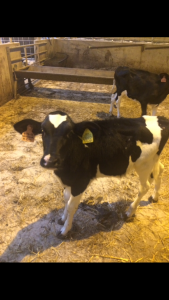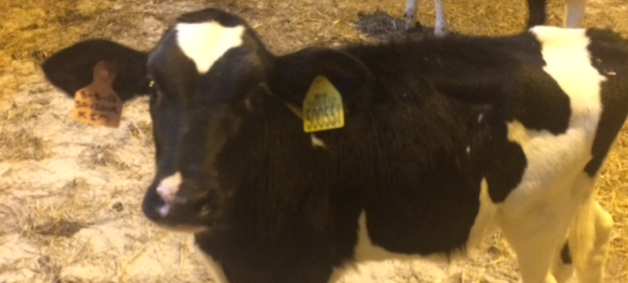This topic was over a two week period. In the first week we visited two farms to learn about how interdependence is a factor affecting farm life. In the second week we had to get with a group and do a study task on Oceanic interdependence.
Week 1
We visited two farms, the first one we visited was a modern farm where the cows were kept indoors. When we arrived you could tell by the clean environment that this was well cared for. When we went in, there was many robotics being used to clean areas, move hay around, milk, massage and feed cows. This was done to keep the farm up-to-date.

When touring the farm, robots were a big part of the functions and helped maintain the system. From the picture above, there is an example of one of the robots which was an electronic feeder (the red robot). This made sure the cows were given three separate feeds a day. It ensured that the cows were given a fair share and cleaned it up to allow easy access for workers.
When calves are born they are separated from a very young age and kept in pens until they can move about.


When they reach a specific age, they are put in a wider pen with other calves which allows them to socialise. I did not agree with how the calves are brought up in this farm as the pens are very secluded and isolates the calves. I believe that as soon as they are born put them in pens which allows them to see beyond a wall. This is a dairy farm and female cows can only produce milk, they did not go into to much detail about what happens to the male calves which makes me believe that they are sent to slaughter houses or are killed as soon as they are born.
An area I felt really positive about at this farm was that the cows are not forced to produce milk. It is really relaxed and they can go whenever they please to get milked by the machine. I think this is a huge step taken in modern farms as they are not abused, which allows them to live a stress free life.

Before I arrived at this farm, I felt very concerned at first about keeping cows indoors. However, when I was shown how comfortable they were as many of their needs were met. This was especially through the robots and also for example the farm had an electric blind which monitored the temperature of the farm and could close it or open it if it was too cold or warm. However, I still believe that animals should have the choice whether to stay outdoors or indoors as it was quite crowded and I don’t believe they receive a lot of exercise.
When we arrived at the second farm and there was already a huge difference in appearance. The second farm was a lot older, however this farm was organic which meant that no chemicals like pesticides are put on the grass which is fed to the cows and also no chemicals in the milk. They changed to an organic farm as the price of milk per litre dropped from 27p to 12p which is a huge drop. They understand that due to an organic farm and having Ayrshire cows means that the milk is of better quality and creamy which many businesses like coffee shops want to use.

I also believe that the way they are brought up is a lot better at the organic farm as they are allowed to go outside on the open grass for exercise and fun. Also the calves are still put in pens however they are more open which allows for them to socialise with other calves. The calves are separated but are kept with mothers for a certain amount of time however, they can freely walk away and aren’t forcefully separated. Also the farmer explained that when male calves are born they never send them to slaughter houses or killed. They grow up indoors and outdoors and are used to help produce offspring.

I felt the cows were more healthy here as there was much more interaction with other cows.
Overall I learned a lot about both farms. I learned that brown cows are native Ayrshire cows which produce less milk however is creamier and contain more fat. I also learned a lot more about modern farming which are beginning to see a change in the function which is introducing more machines. I saw many positives to this as it saves farms a lot of money even if the quality is better. However, I also started to think about workers who have and would loose their jobs due to machines.
Throughout the trip I had to listen a lot to take in new information about the farms. I found the whole experience very inspiring and I have many people about what I observed throughout. Therefore, I believe I have developed my listening and observing skills.
Week 2
In the second week we started the day with a lecture
Lecture 1
This was an assignment briefing for both sections. This included important information about the assignment, areas that we need to think about and also some questions which were answered. I found this very beneficial and helped answer a lot of questions.
Directed study task
For our directed study task we had to create groups and write a piktochart about Oceanic Interdependence.
As a group we read the different readings which we were given beforehand which included:
http://wwf.panda.org/what_we_do/how_we_work/conservation/marine/
http://www.gov.scot/Publications/2011/03/16182005/63 (Detailed information on Scottish Fishing)
https://www.youtube.com/watch?v=jjZtIgQT4KI (Fishing community – family story)
https://www.youtube.com/watch?v=Qn1eSjcRPss (Impact of EU Policy on Peterhead fishery)
https://www.msc.org/healthy-oceans
http://www.seafoodscotland.org/en/quality-standards/marine-stewardship-council.html
http://jncc.defra.gov.uk/default.aspx?page=5473 Endangered species lists
http://www.iucnredlist.org/ (Endangered species list)
This was to enable us to understand more about the impact of interdependence from fishing.
View our piktochart
https://padlet.com/louise_mckie/pybl2vzwsv0b/wish/199020300
I learned a lot from this group task, as we worked together, gave different perspectives, information, explanation and support. I actually felt like I developed more understanding this way more than some lectures in sustainable develop and would like it if we done this more often.
Information which I found interesting was that many fishing areas which have been used for years are now being taken for wind farms, this then affects how much produce fisheries receive, therefore, affects their profits. Many of these difficulties affect local communities who end of loosing many jobs.
I developed my team work, and communication skills throughout the task as we had to share as a team to understand everyone’s research and explain our thought and feelings with the presentation of the piktochart. I also believe that I developed my ICT skills as this was the first time I ever used it and found it easy to create good quality presentations. I will definitely use this in the future and even in the classroom.

